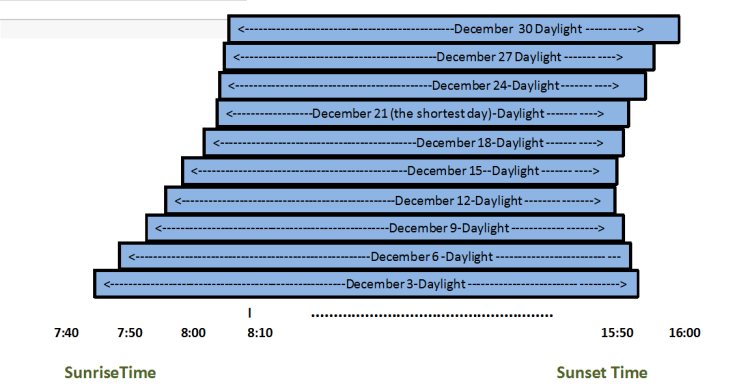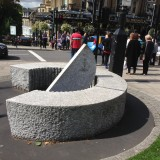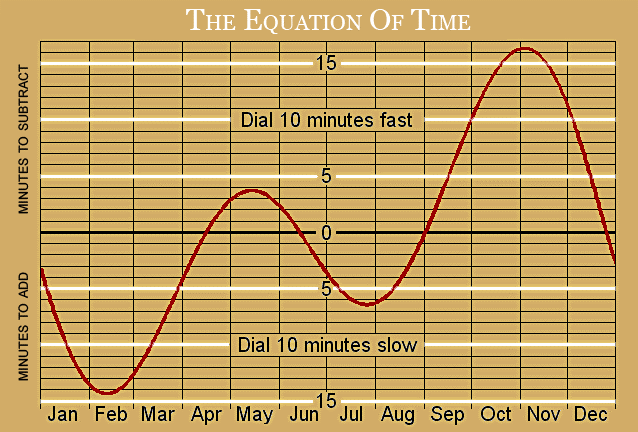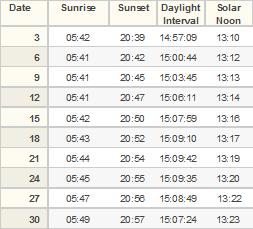Although there is still a week to go until the December solstice, the evenings are already starting to draw out. I have decided to re-blog an edited version of my 2015 post on this topic.
——————————
As I complete this post, it’s completely dark outside and it’s only 5 o’clock in the afternoon; most people I come across think that it will continue to get dark earlier and earlier in the afternoons until 21 December, the shortest day of the year (at least for those of us in the northern hemisphere). This, however, is not the case. In the UK, the evenings start to draw out around ten days or so before the solstice, so it is already getting lighter in the evenings, although it does not start to get lighter in the mornings until early in the new year.
This post aims to explain this interesting phenomenon.
Sunrise and Sunset in December
The table below shows the sunrise and sunset times for London in December.
In the table the daylight interval column shows the number of hours, minutes and seconds between sunrise and sunset. This clearly shows that December 21 has the shortest period of daylight. However, the time of sunrise continues to get later and later throughout the whole of December, whereas the time of sunset starts getting later after December 12. The solar noon is the time of day that the Sun is at its highest in the sky, which is at the mid-point between the times of sunrise and sunset. The table shows that, during December, the solar noon moves later by about 30 seconds each day.
Why does the solar noon shift ?
A solar day, the natural day measured by the rising and setting of the Sun is the period of time between successive solar noons. Its length varies through the year. It is shortest, 23 hours 59 mins 38 seconds, in mid September and longest, 24 hours 30 seconds, around Christmas Day.
.
The graph above shows how the length of a solar day differs from 24 hours. The y-axis shows the difference between the length of a solar day and 24 hours on a given date measured in seconds. So, for example, a value of 10 means a solar day is 24 hours 10 seconds long , 20 means a solar day is 24 hours 20 seconds long , -10 means a solar day is only 23 hours 59 minutes 50 seconds long.
As you can imagine, it would be complete chaos if our clocks and watches had to cope with days of different lengths, so we use 24 hours, the average over the whole year, for all timekeeping purposes.
So, the solar days in December are on average 24 hours and 30 seconds, while our clocks and watches are still assuming that each day is exactly 24 hours. This causes the day to shift about 30 seconds later each day, The shift is why the evenings start drawing out before the solstice but it continues to get darker in the mornings until the new year.
Sundials and the “equation of time”
Before the invention of accurate clocks sundials were widely used to keep time.
Sundial in Harrogate in the North of England
As the length of a solar day varies over the course of a year, the solar time, which is the time given by a sundial, will not be the same as the time measured by a clock which assumes that all days are exactly 24 hours long. Before the invention of accurate clocks in the 17th century because the variation is so small virtually everyone in the world, apart from a very small number of astronomers, would have been unaware of this.
However, in the eighteenth and nineteenth century as mechanical clocks started to take over timekeeping from sundials, the difference between the time measured by an accurate clock which is called mean time and solar time became an issue for everyday life. Astronomers call this difference ‘the equation of time’. It was first calculated and measured by the British astronomer John Flamsteed (1646-1713) in 1673.
As you can see from the diagram, if we were to use a sundial to measure time
- from 15 Apr to 13 June and 1 Sept to 25 December to the sundial would be fast
- from 25 December to 15 Apr and 13 June to 1 September the sundial would be slow.
The days when the differences are greatest are
- November 3/4 when at 11:44 am, a sundial in London would be showing a time of 12 noon
- February 11/12 when at 12:14 pm a sundial in London would be showing a time of 12 noon.
Why does the length of a solar day vary ?
The reason why the length of the solar day varies is due to two different factors.
- The Earth moves in an elliptical orbit around the Sun and its speed varies, being faster in earlier January, when it is closer to the Sun and slower in early July, when it is further away.
- The axis of the Earth’s rotation is tilted.
The combination of these two factors gives the equation of time shown in the picture above. For more details on how these two factors work together to vary the length of the day, see my post How the length of the day varies throughout the year.
There is also a YouTube video
What about the southern hemisphere ?
In the southern hemisphere the longest day is around December 21. What happens is that the Sun starts rising later before December 21, but it doesn’t start getting dark earlier in the evening until well after December 21. This is illustrated in the table below, which shows the sunrise and sunset times for December for Wellington in New Zealand, which lies at a latitude of roughly 41 degrees South.
I hope you have enjoyed this post. To find out more about Explaining Science, click on the Home link at the top of this page.







[…] is still a few days to go until the Winter solstice, sunset is already getting later. Here is a link to a post in the Explaining Science blog which explains what, in astronomical terms, is going […]
LikeLike
[…] Source link […]
LikeLike